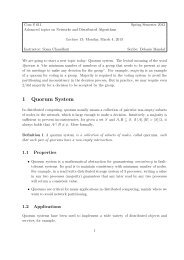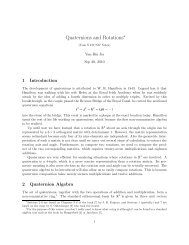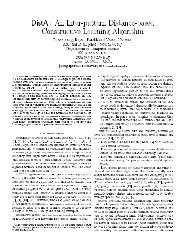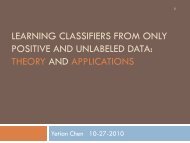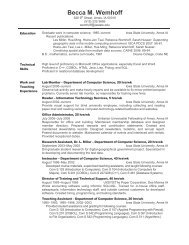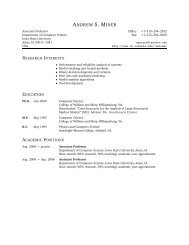Dr. Vasant Honavar Department of Computer Science honavar@cs ...
Dr. Vasant Honavar Department of Computer Science honavar@cs ...
Dr. Vasant Honavar Department of Computer Science honavar@cs ...
Create successful ePaper yourself
Turn your PDF publications into a flip-book with our unique Google optimized e-Paper software.
utilizing other sources <strong>of</strong> data when available – including predicted or known structures <strong>of</strong> the protein but not the<br />
complex, evolutionary pr<strong>of</strong>iles, etc.) As part <strong>of</strong> this effort, we are assembling comprehensive databases <strong>of</strong><br />
protein-protein, protein-RNA, and protein-DNA interfaces, and developing s<strong>of</strong>tware tools for identification <strong>of</strong><br />
protein-protein, protein-RNA and protein-DNA interface residues.<br />
(c) Experimental validation <strong>of</strong> predicted protein-protein and protein-RNA interactions through a number <strong>of</strong><br />
collaborative projects e.g., understanding the significance <strong>of</strong> proline-mediated cis-trans conformational changes<br />
in regulating protein function. Our hypothesis is that the "proline switch" may be widely exploited to regulate<br />
protein-protein and protein-ligand interactions by controlling the transition between two alternative binding<br />
surfaces.<br />
Some results to date include a novel two-stage approach to identification <strong>of</strong> protein-protein interface residues from amino<br />
acid sequence data (Yan, Dobbs and <strong>Honavar</strong>, 2004); an approach to improving the accuracy <strong>of</strong> protein-protein interface<br />
identification using multiple sources <strong>of</strong> information (Sen et al., 2004), and new probabilistic graphical models and related<br />
methods for assigning protein sequences to functional families (Andorf, Silvescu, and <strong>Honavar</strong>, 2004).<br />
Data <strong>Dr</strong>iven Discovery and Refinement <strong>of</strong> Genetic Signaling Pathways and Regulatory Networks (in collaboration<br />
with Heather Greenlee, and Jan Buss, funded in part by a National Institutes <strong>of</strong> Health Grant 5R03EY014931)<br />
Retinal dystrophies (diseases that involve degeneration <strong>of</strong> photoreceptors in the retina) are a major cause <strong>of</strong> blindness.<br />
Age related macular degeneration (AMD), which results in degeneration <strong>of</strong> cone photoreceptors dense macula, affects 10<br />
million people in the United States alone. AMD is an extremely debilitating disease, which robs affected individuals <strong>of</strong> their<br />
high acuity vision. Our research is aimed at understanding the mechanisms that control retinal development and<br />
differentiation. Such understanding can lead to the development <strong>of</strong> therapies involving rehabilitation <strong>of</strong> retinal cells that<br />
can be rescued from degeneration by the application <strong>of</strong> exogenous survival factors and transplantation <strong>of</strong> retinal<br />
progenitor/stem cells into the degenerate retina.<br />
The widely accepted model <strong>of</strong> retinal progenitor differentiation asserts that retinal progenitors pass through successive<br />
intrinsic “competency states” in which they are capable <strong>of</strong> responding to extrinsic cues. The extrinsic signal can<br />
encompass a whole host <strong>of</strong> soluble and cell-cell mediated factors. Intrinsic competence to respond to such external<br />
factors involves expression <strong>of</strong> a number <strong>of</strong> transcription factors as well as expression and plasma membrane localization<br />
<strong>of</strong> appropriate cell surface receptors that make it possible for the progenitors to respond to these cues from the extracellular<br />
environment. Because the ability <strong>of</strong> a progenitor cell to respond to cues from its environment is determined to a<br />
large extent by the proteins present in its proteome, we are investigating changes in expression among plasma<br />
membrane proteins <strong>of</strong> the retinal progenitor cells from several different ages. This provides us with data on the changing<br />
levels <strong>of</strong> protein expression in the developing retina which can be used to discover coordinated patterns <strong>of</strong> gene<br />
expression changes.<br />
Specific computational aims <strong>of</strong> this research include development and applications <strong>of</strong> novel computational approaches to:<br />
data-driven inference genetic regulatory networks, and signaling pathways including:<br />
(a) Discovery <strong>of</strong> co-expressed or co-regulated genes from gene expression patterns<br />
(b) Construction and data-driven refinement <strong>of</strong> genetic networks from gene expression data<br />
(c) Modeling and analysis <strong>of</strong> changes in gene expression patterns and the underlying genetic regulatory networks<br />
and signaling pathways that control retinal development and differentiation<br />
This work builds on our recent results on analysis <strong>of</strong> gene expression in chloroplast biogenesis in maize (Lonosky et al,<br />
2004) and inference <strong>of</strong> temporal boolean network models <strong>of</strong> genetic networks from gene expression data (Silvescu and<br />
<strong>Honavar</strong>, 2001).<br />
Dec 2005<br />
10



